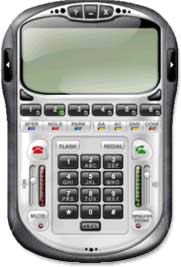Softphones

Softphones for VoIP
SoftPhones (also known as a VoIP Soft Client) are software based IP technology that
allows end users to send and receive calls using a computer and work with a
variety of VoIP codecs.
They
are a program (application) which runs on a computer and lets you dial and connect to a telephone
number through
 a VoIP provider. You can call another
person's telephone or Softphone. They will usually display a virtual dial pad and give the user features much
like a traditional VoIP phone. They are VoIP technology at it's purest, taking
advantage of a computer's resources. The convenience they create for
business travelers, college students and the "Internet Connected" can't be
surpassed. It may be very soon, when office workers look at their
computers as their phone, as well.
a VoIP provider. You can call another
person's telephone or Softphone. They will usually display a virtual dial pad and give the user features much
like a traditional VoIP phone. They are VoIP technology at it's purest, taking
advantage of a computer's resources. The convenience they create for
business travelers, college students and the "Internet Connected" can't be
surpassed. It may be very soon, when office workers look at their
computers as their phone, as well.
The software that allows your PC to act as your phone is usually downloaded from an Internet site. In some cases it can actually be stored on a small disk, or other format that the computer can access. In either case, your PC will need to have the software program that will be your Internet Phone. You will need an Internet connection, preferably a Broadband one, such as DSL, cable or wireless, and an account with a VoIP provider.
Softphone Technical Support:
 This
is an example of a an CounterPath xten softphone interface. By clicking on the
appropriate features you can do most of the things you would be able to do with
a more traditional phone.
This
is an example of a an CounterPath xten softphone interface. By clicking on the
appropriate features you can do most of the things you would be able to do with
a more traditional phone.
There are other SoftPhones, many available for free, which have variations, such as different user GUI interfaces, allow connections with a variety of codecs, and other feature sets that may be desirable depending on your preference. We have put together some other available Softphones, which you can find here. [Softphones free for Windows]
Connection Problems:
Problems logging into the VoIP providers network can be the result of several problems, including authentication and connectivity. "Login Timed Out" or "Cannot Log in to Server" can be error messages related to connectivity or not entering your correct username and password. Three items that are obvious, but important are:
- Internet Connectivity - Make sure you can display a webpage.
- Using the correct username and password for the Softphone account.
- Disable any firewall on your computer.
Connection problems can occur for several other reasons, some of which can be caused by firewalls or secured networks, or double NAT issues. If this is your first time connecting from a new location, but have previously used your Softphone successfully in another location, then you may want to read about issues on certain networks. Many softphones have a firewall discovery and are intelligent about configuring themselves for various firewalls, but even then it is not uncommon to not be able to connect without additional help from the local network administrator.
Calling issues:
If you have logged in successfully to you VoIP provider, and have a dial tone, but can't make or receive calls, there are a few items that you can check. Some of these would be:
- Is the number you are calling a valid one? Try another number, making sure you are dialing correctly according to your dialing plan.
- Is the level of your audio set and is your sound (speakers) working correctly? Reset the audio by opening the Audio Wizard and following the steps.
- Have you enabled the correct codec that will allow you a connection?
If you have a dial tone and can call out, but cannot hear the other party or cannot receive calls, and you have verified your audio settings, then there could be one of the following occurring:
- Check that DND Do Not Disturb has not been inadvertently enabled.
- Firewall or double NAT issues.
If DND is not enabled, try opening another application on top of your softphone, such as Internet Explorer. Then call the softphone from another phone. Does the Softphone rise to the forefront? If so, then check for audio issues, as the signaling is getting to the phone. If audio and DND is not the issue then double NAT could be the culprit. read more
Audio Problems:
There are several factors that can cause audio issues and affect the quality of the voice transmission. The network connection, bandwidth and latency all play a significant role in a good VoIP connection.
![]() For the
best conversations using a Softphone a headset and microphone should be used,
which limits audio feedback. Some others include:
For the
best conversations using a Softphone a headset and microphone should be used,
which limits audio feedback. Some others include:
- Pops during loud points in voice. This can be a symptom of over-modulation. Ask the other party to decrease the volume on his microphone.
- A large amount of background noise. This can be corrected in most cases by adjusting the volume, using any Audio Wizard that your particular provider may offer.
- Echo. This symptom is usually reduced or eliminated by the use of a headset and adjusting the volume.
- Poor or scratchy sound. This is usually caused by latency on the network connection or packet loss, but could also be due to a bad network.
- Choppy audio, almost like a staccato sound. Insufficient bandwidth can result in this effect and will be even more pronounced on three-way conference calls or while files on the same network are being uploaded. Increasing your ISP's level of service (bandwidth) and/or changing the codec to one that uses more compression can greatly help this problem.
Softphone troubleshooting;
Login messages; what they mean:
| Login Message | Explanation | Solution |
|
Discovering Firewall |
SoftPhone X-PRO is discovering the type of firewall that it is behind. |
Allow the SoftPhone X-PRO to discover the firewall type, which will be needed for it to auto-configure some of the network settings. |
|
Logging in |
SoftPhone X-PRO is attempting to register with the SIP Proxy Server. |
Wait to verify success. This may take a few seconds. |
|
"Logged in - Enter Phone Number" |
SoftPhone X-PRO has successfully registered with the configured SIP servers. |
SoftPhone X-PRO is ready. |
|
"Failed to Load Settings from the Server." |
One or more SIP registrations failed. |
Verify the connection to the internet. Verify username and password are correct. Check Diagnostic Log to verify that SIP messaging is being received through your firewall. |
|
"Enter Phone Number" |
SoftPhone X-PRO has successfully registered with ALL configured SIP servers. |
The SoftPhone X-PRO should be ready for calling. |
|
"Call failed: 480 Temporarily unavailable" |
Dialed SIP number is not on-line at this time. |
Make a test call to a known working number, as a test. |
|
"Trying" (long period) |
SIP Call being established by SIP message protocol |
Manually configure network setting dialog screen; auto-detect has failed to detect proper settings. |
|
"Connected" |
Called party has answered and is ready to converse. |
Call has been properly established. |


